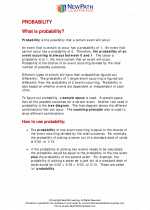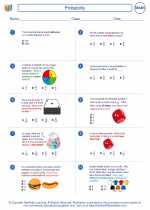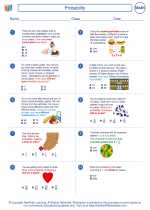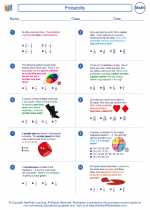Six-Sided Die: Explanation and Study Guide
A six-sided die, also known as a d6, is a cube with each face showing a different number from 1 to 6. It is a common tool used in many games and probability experiments. Understanding the properties and possibilities of a six-sided die is important for various mathematical and gaming applications.
Properties of a Six-Sided Die
Key properties of a six-sided die include:
- It has six faces, each labeled with a different number from 1 to 6.
- The opposite faces of the die always add up to 7 (e.g., 1 and 6, 2 and 5, 3 and 4).
- When the die is rolled, each face has an equal probability of landing face-up.
Study Guide
Here are some key concepts and topics to study related to six-sided dice:
- Basic Counting: Understand the basic concept of counting the number of outcomes when rolling a six-sided die.
- Probability: Learn about the concept of probability and how it relates to rolling a six-sided die. Calculate the probability of landing on a specific number or a range of numbers.
- Sum of Two Dice: Explore the possible sums when rolling two six-sided dice. Use this to understand the concept of probability distributions and the likelihood of getting specific sums.
- Games and Applications: Study how six-sided dice are used in various games, such as board games, role-playing games, and gambling. Understand the role of probability in these applications.
- Mathematical Notation: Familiarize yourself with the mathematical notation used to represent the outcomes of rolling a six-sided die, such as using the numbers 1 to 6 or the symbol "d6."
By mastering these concepts, you can develop a solid understanding of the properties and applications of six-sided dice, as well as strengthen your skills in counting, probability, and mathematical reasoning.
Good luck with your studies!
.◂Math Worksheets and Study Guides Sixth Grade. Probability
Study Guide Probability
Probability  Worksheet/Answer key
Worksheet/Answer key Probability
Probability  Worksheet/Answer key
Worksheet/Answer key Probability
Probability  Worksheet/Answer key
Worksheet/Answer key Probability
Probability 

 Worksheet/Answer key
Worksheet/Answer key
 Worksheet/Answer key
Worksheet/Answer key
 Worksheet/Answer key
Worksheet/Answer key

The resources above cover the following skills:
Statistics and Probability (SP)
Develop understanding of statistical variability.
Recognize a statistical question as one that anticipates variability in the data related to the question and accounts for it in the answers. For example, “How old am I?” is not a statistical question, but “How old are the students in my school?” is a statistical question because one anticipates variability in students’ ages.
Ability to introduce and develop statistical reasoning.